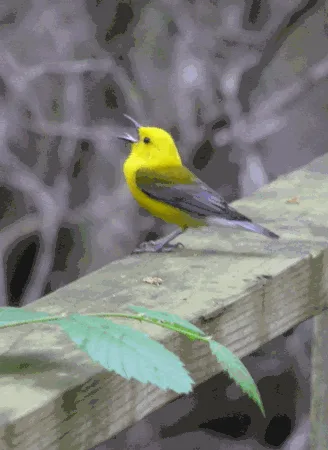
Prothonotary Warbler
[order] Passeriformes | [family] Parulidae | [latin] Protonotaria citrea | [UK] Prothonotary Warbler | [FR] Paruline orangee | [DE] Zitronenwaldsanger | [ES] Chipe Anaranjado | [IT] Protonotaria citrina | [NL] Citroenzanger
Subspecies
| Genus | Species | subspecies | Breeding Range | Breeding Range 2 | Non Breeding Range |
| Helmitheros | citrea | ||||
| Protonotaria | citrea | NA | e, se USA | MA, West Indies, n SA |
Physical charateristics
Size and structure, large, full-bodied, long-billed, make the Prothonotary Warbler an unlikely candidate for confusion with other warbler species. It is also distinctive in plumage, with bright-yellow head and breast, greenish-yellow back, and bluish wings. When spread, the bluish upperside of the tail shows large white spots. The underside of the tail is mostly white, extending onto the undertail coverts. The Blue-winged Warbler is somewhat similar in coloration but has a dark line through the eye and prominent white wingbars, in addition to being considerably smaller and more slender.
Listen to the sound of Prothonotary Warbler
[audio:http://www.aviflevoland.nl/sounddb/P/Prothonotary Warbler.mp3]
Copyright remark: Most sounds derived from xeno-canto
| wingspan min.: | 0 | cm | wingspan max.: | 0 | cm |
| size min.: | 12 | cm | size max.: | 13 | cm |
| incubation min.: | 12 | days | incubation max.: | 14 | days |
| fledging min.: | 11 | days | fledging max.: | 12 | days |
| broods: | 1 | eggs min.: | 4 | ||
| eggs max.: | 6 |
Range
Prothonotary Warblers can be found nesting across much of the eastern United States, ranging from Florida and eastern Texas north to Wisconsin, western New York, and northern New Jersey. Their breeding stronghold, however, is in the lowlands of the southeastern United States
Habitat
Found in flooded deciduous forests of the eastern U.S. during the summer breeding months, especially around black willow, sweetgum, river birch, ash, and near cypress swamps. They can also be found along forested lakeshores or riparian areas near still or very slowly moving water. They winter in lowland forests and swamps in the tropics.
Reproduction
Prothonotary Warblers breed in wooded swamps, flooded bottomland forests, and along slow-moving rivers. As the only eastern wood warblers that nest in cavities, the birds often use old Downy Woodpecker nests in dead snags. They will also utilize nest boxes for nesting, which begins in April. The female builds the nest, using mostly mosses and liverworts. The female then incubates a typical clutch of four to six eggs for 12 to 14 days. Young birds leave the nest after about 11 days at which time it has been claimed that they can swim if necessary. In the southern part of their breeding range, Prothonotary Warblers will nest twice in one season.
Feeding habits
Usually forages fairly low in vegetation, very often above water. Will also hop along floating vegetation and logs, poking in crevices for food items. Primarily feeds on insects, especially aquatic insects. Will also feed on spiders, seeds, and snails.
Conservation
This species has a large range, with an estimated global Extent of Occurrence of 2,200,000 km². It has a large global population estimated to be 1,800,000 individuals (Rich et al. 2003). Global population trends have not been quantified, but the species is not believed to approach the thresholds for the population decline criterion of the IUCN Red List (i.e. declining more than 30% in ten years or three generations). For these reasons, the species is evaluated as Least Concern.

Migration
It breeds in hardwood swamps in southern Canada and the eastern United States and winters in the West Indies, Central America and northern South America.
Distribution map

Literature
Title PROTHONOTARY WARBLERS CROSS THE GULF OF MEXICO TOGETHER
Author(s): FRANK R. MOORE
Abstract: Field observationos f “marked” ProthonotaryW arble..[more]..
Source: Field Ornithol., 61(3):285-287
Title Prothonotary Warbler Nest Success and Vegetation
Characteristics in a Fragmented Oklahoma Landscape
Characteristics in a Fragmented Oklahoma Landscape
Author(s): Douglas R. Wood
Abstract: In 2003, I studied the relationship between protho..[more]..
Source: Proc. Okla. Acad. Sci. 84: pp 27-31 (2004)
Title Retaliatory mafia behavior by a parasitic cowbird
favors host acceptance of parasitic eggs
favors host acceptance of parasitic eggs
Author(s): Jeffrey P. Hoover and Scott K. Robinson
Abstract: Why do many hosts accept costly avian brood parasi..[more]..
Source: PNAS Early Edition, 2003
]]>
